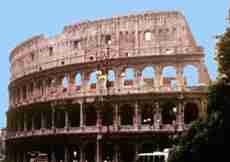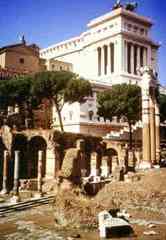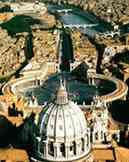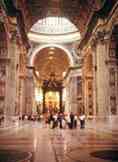Rome: The Eternal City
The energy of Rome at night -- floodlit piazzas abuzz with people enjoying the old city and each other. We were both observers and players: people-watching and strolling through the piazzas, by the fountains and outdoor cafes. Street musicians and local Casanovas provided the entertainment. Rome’s strolling extravaganza tops that of any other European city.
 |
Only a few hours earlier we had traveled to the fabled city with apprehension. We knew we could not afford to miss Rome’s unique offerings, yet we were concerned...how to get around, deal with the crowds, and do justice to Rome in a two-day visit? Now we already felt comfortable, even heady, with the Italian joy of life. Our hotel was in the heart of old Rome, near Campo Fiori and Piazza Navona, a short walking distance from the Pantheon, Rome’s famous fountains, the Spanish Steps, the Tiber River, and the Vatican. Ancient Rome’s Colosseum and Forum were but ten minutes by bus or taxi. |
Roman Rubble
| When we arrived in Rome earlier that day, we toured the vast Colosseum and imagined its heyday 2,000 years ago: 50,000 spectators; gladiators and animals packed into pens below the arena. Fight-to-the-death matches rivaled today’s Super Bowls or Tyson bouts for blood-letting. It would have been better to be a spectator than a participant here. The Colosseum ruins exhibit the full grandeur of the engineering. A wall section remains at full height, and the sub-arena pens are exposed. |  |
 |
The Roman Forum extends to the northwest from the Colosseum. Our guidebook (a chapter of Rick Steves’ Mona Winks) enabled us to decipher the rubble. Finding Via Sacra, the main street, we strolled the wide expanse. We imagined the huge Basilica Maxentius towering over us with toga-clad patricians walking alongside. A few still-standing columns helped us to orient ourselves. The sole standing complete structure was the Curia that housed the Roman senate, the model of modern democracy. Walking up the Capitolian Hill from the Forum, we came upon the Renaissance buildings which today house the city government. At the top of the hill is Campidoglio Square, designed by Michelangelo, bordered by two museums and the city hall. |
| Descending Michelangelo’s stairs, we headed a few short blocks to the Pantheon, ancient Rome’s best-preserved and most impressive building. With splendid granite columns and original brass doors, the Pantheon looks onto its neighboring piazza. The 140 foot dome was the world’s largest for 1,200 years until Florence’s cathedral was crowned during the Renaissance. The interior of the Pantheon is a marvel, fully illuminated with a single opening in the dome. The walls and floor perimeter hold the tombs of many famous Italians, including that of the artist, Raphael. |  |
St. Peter’s and the Vatican
We devoted the next day to Christianity’s most famous sites in Vatican City, a separate principality of 100 acres in the heart of Rome. Piazza San Pietro, fronting St. Peter’s Basilica, was impressive with its ellipse of encircling columns. As we walked up the steps and entered the Basilica, we had no doubt that it is the richest, most impressive church on earth. Gasp! It felt almost too long, too high, and too ornate. Baroque scrolls, cherubs, and statues adorned the walls and columns. Michelangelo’s dome is the world’s largest. Taking an elevator to the half-way point, we peered down on the main altar, then climbed 330 claustrophobic steps to the top for an impressive Rome vista.
 |
 |
 |
 |
That afternoon we savored the Vatican Museum. One of the highlights was Raphael’s large wall painting titled "School of Athens." Raphael depicted the great pre-Christian thinkers, Aristotle, Plato, etc., with the faces of the leading artists of Raphael’s day, including competitor, Michelangelo. Other highlights included Greek sculpture which inspired Renaissance artists. At the end of the long self-guided museum tour we came to the Sistine Chapel and Michelangelo’s ceiling. No other work of art can compare with its power and magnificence. Painted as he lay on scaffolding for four years (1508-1512), it depicts the biblical story of Creation in nine scenes. After gazing enthralled until our necks hurt, we studied Michelangelo’s "Last Judgment" behind the altar. This was painted at the end of his life during the Counter Reformation.
Fountains Galore
 |
That evening we again enjoyed Rome’s spirited outdoor scene, visiting Piazza Navona with its three Baroque fountains by Bernini. Finding a table at one of the outdoor cafes, we relished the Tartufo "death by chocolate" gelato. We strolled Via del Corso and many piazzas. Languishing at the Trevi Fountain, Rome’s most spectacular with its Neptune statue, we remarked on successfully experiencing Rome’s grandeur in two short days and nights. The next morning we walked to the metro with our packs, passing Gucci’s in Rome’s ritziest shopping area. On our next visit, we plan to see Rome’s ancient port city, Ostia Antica, and to again enjoy Rome’s whirl of history, sites, and sensations. |
Click here for details to plan your own trip to Rome.
Les and Rita Furnanz